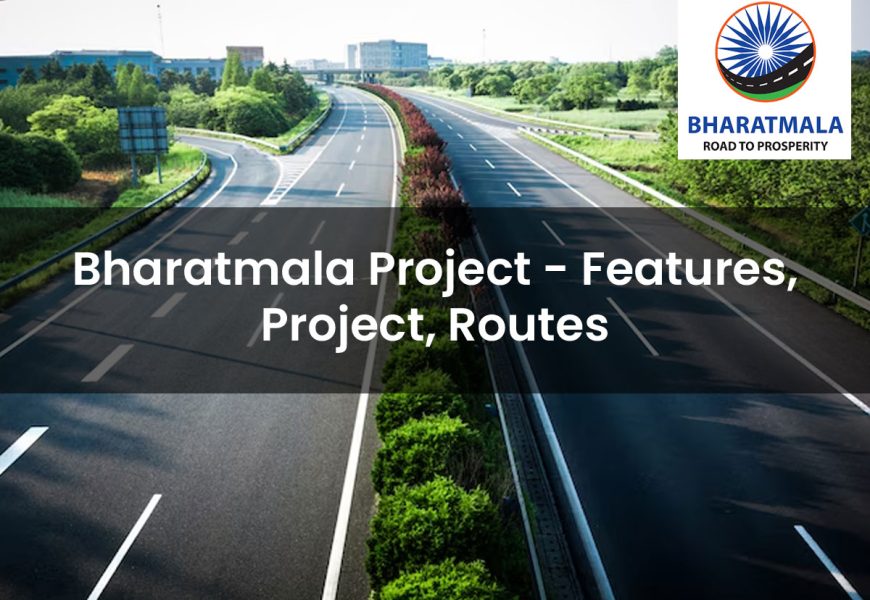Any nation’s development relies heavily on its transportation networks and how well they are maintained. This is especially true for a large and populous country like India. Constructing new and improved roads is essential to ensure smooth traffic flow and better connectivity. The Bharatmala project aims to achieve this by laying down a series of new roads across the country.
Bharatmala Pariyojana is an ambitious program for the highways sector. It focuses on improving the efficiency of freight and passenger movement across India. This will be done by addressing critical infrastructure gaps through various initiatives, such as developing Economic Corridors, Inter Corridors, Feeder Routes, improving National Corridor Efficiency, and building roads for Border and International connectivity, Coastal and Port connectivity, and Green-field expressways.
The Bharatmala Project was unveiled by Shri Nitin Gadkari in the esteemed presence of Prime Minister Shri Narendra Modi, who conceived the idea for this transformative nationwide road network improvement scheme. The Ministry of Road Transport and Highways, under their watchful guidance, will oversee all key aspects of this monumental project, a testament to the government’s unwavering commitment to infrastructure development.
What is the Bharatmala Project?
The Bharatmala Pariyojna is an ambitious project that aims to interconnect 550 district headquarters. Currently, 300 are interconnected by 4-lane highways. The project would also build bridges, tunnels, flyovers, elevated corridors, bypasses, etc. These additions aim to provide shorter, congestion-free, and optimised connectivity to various places. This centrally sponsored and funded project by the Government of India will encompass all existing highway projects, including the National Highways Development Project (NHDP) initiated by the Atal Bihari Vajpaye government in 1998.
Bharatmala primarily focuses on connecting remote areas and satellite cities of major metros like Bengaluru, Pune, and Hyderabad. The project plans to develop 83,677 km (51,994 miles) of new highways with a total investment of ₹10.63 lakh crore (US$130 billion). This makes it the largest government road construction initiative as of March 2022.
Components of Bharatmala Pariyojna
The Bharatmala project is a comprehensive initiative by the central government to enhance road infrastructure across India. Here are its key components:
- Economic Corridors: The project will construct 9,000 km of Economic Corridors to boost connectivity and economic activities.
- Feeder Routes or Inter Corridors: A total of 6,000 km of roads will be developed under this category to support the main corridors.
- National Corridor Efficiency Improvement: This includes 5,000 km of roads to enhance connections within the National Corridor network.
- Border Road and International Connectivity: To connect cities and remote areas near borders, 2,000 km of roads will be built, improving links with neighbouring countries.
- Port Connectivity and Coastal Roads: The project plans 2,000 km of roads to connect coastal areas and important ports, enhancing trade routes.
- Green Field Expressways: Focused on new expressways, this component aims to better manage traffic and freight with modern infrastructure.
- Balance NHDP Works: The project will also cover 10,000 km of new roads, continuing the work of the National Highways Development Project (NHDP).
Objectives: Bharatmala Project
The Bharatmala project aims to improve the efficiency of the National Corridor, including the Golden Quadrilateral, North-South and East-West corridors. This will be achieved by decongesting choke points through elevated corridors, bypasses, ring roads, lane expansions, and logistics parks.
Additionally, the project includes constructing Border Roads of strategic importance and International Connectivity roads to promote trade with Myanmar, Bangladesh, Bhutan, and Nepal.
The program has identified approximately 26,200 km of Economic Corridors with heavy freight traffic. The goal is to develop these corridors end-to-end, ensuring seamless travel and uniform standards. Feeder Corridors will address infrastructure gaps in various regions.
All projects under Bharatmala will undergo technical, financial, and economic appraisal by an empowered Project Appraisal & Technical Scrutiny Committee. This committee will be established within the National Highways Authority of India (NHAI) and the Ministry of Road Transport and Highways (MoRTH).
Phase-I of Bharatmala
Phase-I of the Bharatmala Pariyojana includes the development of the following road projects:
| Sr. No. | Scheme | Length (km) | Cost (₹crore) |
| 1. | Economic Corridors | 9,000 | 1,20,000 |
| 2. | Inter-Corridors & Feeder Roads | 6,000 | 80,000 |
| 3. | National Corridor Efficiency Improvement | 5,000 | 1,00,000 |
| 4. | Border & International Connectivity Roads | 2,000 | 25,000 |
| 5. | Coastal & Port Connectivity Roads | 2,000 | 20,000 |
| 6. | Expressways | 800 | 40,000 |
Comprehensive Development Strategy
To eliminate overlap and ensure comprehensive development, all remaining works under various phases of the National Highways Development Project (NHDP) will be integrated into the Bharatmala Pariyojana. Additionally, projects under schemes such as NH(O), SARDP-NE, EAP, and LWE will continue under their respective programs.
Features of the Bharatmala Project
Bharatmala Pariyojana is a flagship initiative aimed at enhancing road infrastructure and facilitating trade through improved road transportation. Key features of this scheme include:
- Development Focus: The primary objective is to elevate the quality of roads across the country, spurring development in every region.
- Extensive Road Construction: A significant aspect of the scheme is the construction of new roads to enhance connectivity.
- Five-Year Completion Goal: The government intends to complete all road projects under this scheme within a five-year timeframe.
- Diverse Funding Sources: Recognizing that government funding alone may not suffice, the Ministry seeks additional financial sources to ensure the project’s completion.
- Categorised Project Execution: The project is divided into various categories to streamline construction, allowing for more efficient and organised execution.
Challenges of the Bharatmala Project
Announced in 2017 with an initial target completion date of 2022, the Bharatmala project faces significant delays. Increased land costs and budget overruns are major factors contributing to its slow progress.
To address these financial challenges, the Central Government is seeking additional investments, including market funds and private investments. If the estimated budget shortfall persists, the Government plans to auction completed highway projects or explore foreign debt and bond markets to secure necessary funding.
Bharatmala Funding Routes
Bharatmala Routes
The government will fund the Bharatmala project through four primary routes:
- Market borrowings
- Central Road Fund
- Monetizing government-owned road assets
- Budgetary allocation
Of the total funds required, Rs. 2 lakh crore will be raised through market borrowings, while Rs. 1 lakh crore will come from the Central Road Fund and toll collections by the NHAI.
The project aims to significantly boost economic growth by expanding road corridors from 6 to 50. Through the Bharatmala Project, the Central Government seeks to enhance trade, improve the condition of National Highways, and strengthen the overall road network across the country.
FAQs on Bharatmala Project
Which state has the highest national highways in India?
Uttar Pradesh boasts the longest network of National Highways in India, featuring 35 highways throughout the state.
Which state has the longest chain of roads?
Rajasthan, the largest state in India, has an extensive road network. It includes 6,373 kilometres of National Highways and a total road network of 150,876 kilometres, connecting all parts of the country.
Which is the longest highway in India?
National Highway 44 (NH 44), previously known as National Highway 7, is the longest highway in India. Stretching 3,745 kilometers, it runs from Srinagar in the north to Kanyakumari in the south, covering the North-South Corridor.
How many districts are connected in the Bharatmala project?
The Bharatmala project aims to enhance connectivity by increasing the number of corridors from 6 to 50 and connecting 550 districts with a minimum of 4-lane highways, up from the current 300 districts.
What is the purpose of Bharatmala?
Proposed by Shri Nitin Gadkari, the Minister of Road Transport and Highways, in 2015, the Bharatmala project aims to ensure the smooth movement of freight and passengers, thereby facilitating better trade relationships through improved road connectivity.















